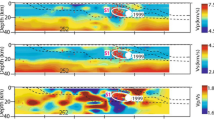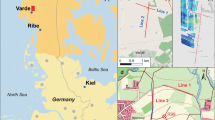Abstract
Local seismic shear wave anisotropy is studied with recordings of microearthquakes near Landau and Insheim in the central Upper Rhine Graben, SW Germany. Although the recordings have a low signal-to-noise level and there is a complex heterogeneous 3-D tectonic structure, a time separation δt between horizontally polarised SH-waves and vertically polarised SV-waves can be observed in seismograms and particle motion diagrams. The observations can be explained by azimuthal anisotropy in the upper crust with a direction φ 0 = 155° east of north for the fast polarisation direction of SV-waves. A gradient of time separation with distance x of δt/x ~ 10 ms/km can explain the data. This model can be interpreted with a classical scenario of fluid-filled (sub-)vertical cracks with a preferred NNW-SSE orientation. Known faults strike NNW-SSE around Landau and Insheim and the seismicity pattern is also oriented in this direction. This direction coincides with the regional orientation of the maximum horizontal stress (σ H ), and fluids apparently exist at depth as known from geothermal water extraction. Furthermore, we find that 3-D seismic velocity heterogeneities have a much larger influence on the precision of the microearthquake location than the anisotropy effect in this complex tectonic region. This is obvious from the up to five times larger travel time residuals (maximum −0.5 s and +0.35 s), which are used as station corrections during the location procedure, compared to the anisotropic δt observations (maximum 0.1 s).










Similar content being viewed by others
References
Babuška, V., and Cara, M. (1991), Seismic anisotropy in the earth (Kluwer Academic Publishers, Dordrecht.
Barth, A., Delvaux, D., and Wenzel, F. (2009), Tectonic stress field in rift systems – a comparison of Rhinegraben, Baikal Rift and East African Rift, Cahiers du Centre Européen de Géodynamique et de Séismologie 28, Luxembourg.
Baumgärtner, J., and Lerch, C. (2013), Geothermal 2.0: The Insheim geothermal power plant, the second generation of geothermal power plants in the Upper Rhine Graben, in: Third European Geothermal Review, Papers and Abstracts, BESTEC GmbH, Landau, 9-10.
Buchmann, T., (2008), 3D multi-scale finite element analysis of the present-day crustal state of stress and the recent kinematic behaviour of the northern and central Upper Rhine Graben, dissertation, Vrije Universiteit Amsterdam.
Crampin, S. (1978), Seismic wave propagation through a cracked solid: polarisation as a possible dilatancy diagnostic, Geophys. J. R. astr. Soc. 53, 467-496.
Crampin, S., and Lovell, J.H. (1991), A decade of shear-wave splitting in the Earth’s crust: what does it mean? what use can we make of it? and what should we do next? Geophys. J. Int. 107 387-407.
Crampin, S., and Chastin, S. (2003), A review of shear wave splitting in the crack-critical crust, Geophys. J. Int. 155, 221-240.
Cuenot, N., Dorbath, C., and Dorbath, L. (2008), Analysis of the microseismicity induced by fluid injections at the EGS site of Soultz-sous-Forêts (Alsace, France): Implications for the characterization of the geothermal reservoir properties, Pure appl. geophys. 165, 797–828.
Douglas, A, Bowers, D., and Young, J.B. (1997), On the onset of P seismograms, Geophys. J. Int. 129, 681-690.
Expertengruppe (2010), Das seismische Ereignis bei Landau vom 15. August 2009. Abschlussbericht, http://www.lgb-rlp.de/fileadmin/cd2009/images/content/endbericht_landau/Landau_Endbericht_101103_corr.pdf, last access 31. Oct. 2013.
Faber, S., Bonjer, K.-P., Brüstle, W., and Deichmann, N. (1994), Seismicity and structural complexity of the Dinkelberg block, southern Rhine Graben, Geophys. J. Int. 116, 393-408.
Frietsch, M., (2013) Seismische Scherwellenanisotropie der Oberkruste in der Südpfalz, diploma thesis, Karlsruhe Institute of Technology, Geophysical Institute, in German.
GeORG-Projektteam (2013), Geopotenziale des tieferen Untergrundes im Oberrheingraben, Fachlich-Technischer Abschlussbericht des Interreg-Projekts GeORG, Teile 1–4. – Internet (PDF-Dokument: http://www.geopotenziale.eu, last access 27. Oct. 2013).
Granet, M., Glahn, A., and Achauer, U. (1998), Anisotropic measurements in the Rhinegraben area and the French Massif Central: geodynamic implications, Pure appl. geophys. 151, 333-364.
Groos, J., and Ritter, J. (2010), Seismic noise: A challenge and opportunity for seismological monitoring in densely populated areas, in Ritter, J., and Oth, A. (eds.) Proceedings of the Workshop: Induced Seismicity, Cahiers du Centre Européen de Géodynamique et de Séismologie 30, 87-97.
Groos, J., Zeiß, J., Grund, M., and Ritter, J. (2013), Microseismicity at two geothermal power plants at Landau and Insheim in the Upper Rhine Graben, Germany, Geophys. Res. Abstr., 15, EGU2013-2742.
Kendall, J.-M., Stuart, G.W., Ebinger, C.J., Bastow, I.D., and Keir, D. (2005), Magma-assisted rifting in Ethiopia, Nature, 433, 146-148.
Liu, E., and Crampin, S. (1990), Effects of the internal shear wave window: Comparison with anisotropy induced splitting, J. geophys. Res. 95, 11,275-11,281.
Moninger, R., (1985) Neotektonische Bewegungsmechanismen im mittleren Oberrheingraben, dissertation, Universität Karlsruhe (TH), Germany, in German.
Peters, G., and van Balen, R.T., (2007), Tectonic geomorphology of the northern Upper Rhine Graben, Germany, Global and Planetary Change 58, 310-334.
Plenefisch, T., Faber, S. and Bonjer, K.-P. (1994), Investigations of Sn and Pn phases in the area of the upper Rhine Graben and northern Switzerland, Geophys. J. Int. 119, 402-420.
Plenefisch, T., and Bonjer, K.-P. (1997), The stress field in the Rhine Graben area inferred from earthquake focal mechanisms and estimation of frictional parameters, Tectonophysics 275, 71-97.
Plenkers, K., Ritter, J.R.R., and Schindler, M. (2013), Low signal-to-noise event detection based on waveform stacking and cross-correlation: application to a stimulation experiment, J. Seismol. 17, 27-49.
Plešinger, A., Hellweg, M., and Seidl, D. (1986), Interactive high-resolution polarization analysis of broad-band seismograms, J. Geophysics 59, 129-139.
Ritter, J.R.R., and Wagner, M. (2008), High-resolution SKS anisotropy indicates asthenospheric flow below SW Germany, Geophys. Res. Abs. 10, EGU2008-03951.
Ritter, J.R.R., Wagner, M., Bonjer, K.-P., and Schmidt B. (2009), The Heidelberg and Speyer earthquakes and their relationships to active tectonics in the central Upper Rhine Graben, Int. J. Earth Sci. 98, 697-705.
Ritter, J., Gassner, L., and Groos, J. (2013), Fault plane solutions of microseismic events near Landau and Insheim, SW Germany, Geophys. Res. Abstr. 15, EGU2012-5630.
Rummel, F., Möhring-Erdmann, G., and Baumgärtner, J., (1986), Stress constraints and hydrofracturing stress data for the continental crust, Pure appl. geophys. 124, 875-895.
Schad, A. (1962), Das Erdölfeld Landau, Abh. geol. Landesamt Baden-Württemberg 4, 81-101.
Schindler, M., Baumgärtner, J., Gandy, T., Hauffe, P., Hettkamp, T., Menzel, H., Penzkofer, P., Teza, D., Tischner, T., and Wahl, G. (2010), Successful hydraulic stimulation techniques for electric power production in the Upper Rhine Graben, Central Europe. Proceedings World Geothermal Congress 2010 Bali, Indonesia, 7 pages.
Schweitzer, J. (2001), HYPOSAT—an enhanced routine to locate seismic events, Pure applied Geophys. 158, 277-289.
Simpson, D.W. (1986), Triggered earthquakes, Ann. Rev. Earth Planet. Sci. 14, 21-42.
Valley, B., and Evans, K.F. (2007), Stress state at Soultz-sous-Forêts to 5 km depth from wellbore failure and hydraulic observations, Proceedings of the 32nd Workshop on Geothermal Reservoir Engineering, Stanford, SGP-TR-183.
Zeiß, J. (2013), Präzise Lokalisierung mikroseismischer Ereignisse im Umfeld geothermischer Kraftwerke in der Südpfalz, diploma thesis, Karlsruhe Institute of Technology, Geophysical Institute, in German.
Zheng, Z. (2000), Seismic anisotropy due to stress-induced cracks, Int. J. Rock Mech. Mining Sci. 37, 39-49.
Acknowledgments
We thank P. Knopf, R. Plokarz and W. Scherer for help with data acquisition and processing, and Prof. G. Eisbacher for fruitful discussions. Jens Zeiß provided hypocentre information. Seismic waveforms for this study were kindly provided by BESTEC GmbH, geo x GmbH, Exorca GmbH, DMT GmbH & Co. KG and the KIT KABBA datacentre. Data of tectonic elements were provided by the GeORG Projektteam (2013) and we thank J. Tesch, and B. Schmidt (LGB Mainz) for information on the geology. The editor Steward Greenhalgh and an anonymous reviewer helped to clarify several points in the manuscript. This study is part of the research project MAGS (Microseismic Activity of Geothermal Systems) which is funded by the Federal Ministry for the Environment, Nature Conservation and Nuclear Safety of the Federal Republic of Germany (FKZ 0325191A-F) and supervised by Projektträger Jülich (PT-J).
Author information
Authors and Affiliations
Corresponding author
Rights and permissions
About this article
Cite this article
Frietsch, M., Groos, J.C. & Ritter, J.R.R. Detection and Delineation of a Fracture Zone with Observation of Seismic Shear Wave Anisotropy in the Upper Rhine Graben, SW Germany. Pure Appl. Geophys. 172, 267–282 (2015). https://doi.org/10.1007/s00024-014-0899-3
Received:
Revised:
Accepted:
Published:
Issue Date:
DOI: https://doi.org/10.1007/s00024-014-0899-3




